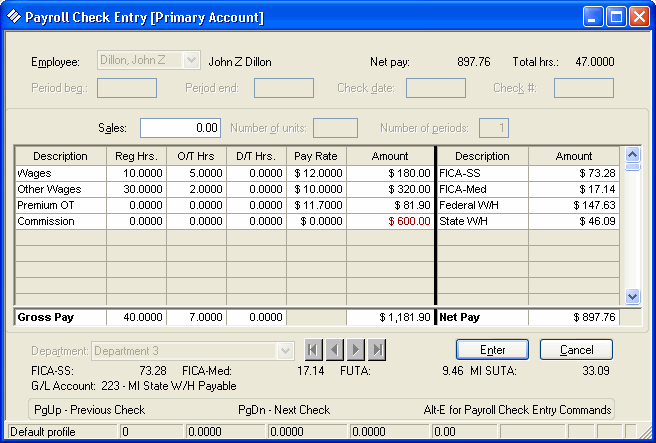Warning
Product support for the Creative Solutions Accounting platform ended on September 30, 2020.
Help & How-To Center content for the Creative Solutions Accounting platform may be outdated and is used at your own risk.
Calculating overtime payments using the weighted average method is done for a variety of reasons. Some examples follow.
- A piecework employee works at differing pay rates during a single pay period and the amount of overtime worked in each pay rate is not determinable.
- A non-exempt worker has overtime hours and is partially compensated by a non-hours based payment, such as commission.
- A salaried non-exempt employee is paid a fixed salary for a fluctuating workweek and still needs to be compensated for overtime hours on a "half-time" basis.
Note: If you are required to calculate overtime for salaried non-exempt employees by the half-time calculation, you can accomplish this with CSA by using a salaried hours insensitive pay item.
CSA will not verify that the salary is large enough to ensure that the recalculated hourly wage does not fall below the minimum wage for salaried, non-exempt employees.
A common use of the weighted average overtime calculation, also called blended overtime, is in auto-repair shops. In addition to the hourly pay rate, a mechanic may be paid commission on completed repairs. In such a case, the commission should be included in compensation rates when calculating the overtime rate. As calculated by CSA, and in contrast to the typical overtime calculation, weighted average overtime is a separate premium calculation and is not included with the regular pay items.
- Payroll check entry calculates the premium portion (.5) of overtime and multiplies it by the overtime hours entered.
- The straight-time portion of overtime hours (1.0) appears on the pay item, and the premium portion (.5) appears on the WAOT pay item in payroll check entry.
- All employees with the WAOT pay item are considered non-exempt.
- Amounts will be allocated back to departments.
- Use only one WAOT pay item per employee per department. All pay items on an employee are subject to the WAOT calculation method if the WAOT pay item is set up on an employee in at least one department. The only way to avoid calculating all pay items in all departments using WAOT is to set up new (excluded) pay items. See Excluding specific pay items from weighted average overtime.
- You must enter overtime (OT) hours in payroll check entry in order for WAOT to calculate properly. WAOT will only calculate based on the number of overtime hours entered in the O/T hrs column in payroll check entry.
- The frequency of the WAOT pay item must be the same as the frequency of the items subject to the WAOT calculation.
- For multiple departments - WAOT is calculated across all departments then allocated to WAOT items based on the overtime hours worked in each department. Therefore, if you have multiple departments and a WAOT item in only one department, WAOT amounts from all departments will appear in that one item. If the WAOT item is in every department, the WAOT amount will be allocated based on the proportion of overtime hours worked in each department.
Example payroll check entry screen
In this example, Premium OT is the weighted average overtime pay item.

The calculation is as follows
| 15 hours (10 reg +5 OT) @ $12.00 | $180.00 |
| + 32 hours (30 reg +2 OT) @ $10.00 | $320.00 |
| + Commission | $600.00 |
| = | $1100.00 |
| $1100 ÷ 47 (total hours) = $23.40 (Regular rate) |
| $23.40 (Regular rate) x .5 (WAOT rate) = $11.70 (Premium rate) |
| $11.70 (Premium rate) x 7 (number of OT hours) = $81.90 (WAOT amount). |
Related topics
Creating a global pay item for weighted average overtime (WAOT)
Setting up employees with a weighted average overtime (WAOT) pay item
Was this article helpful?
Thank you for the feedback!



